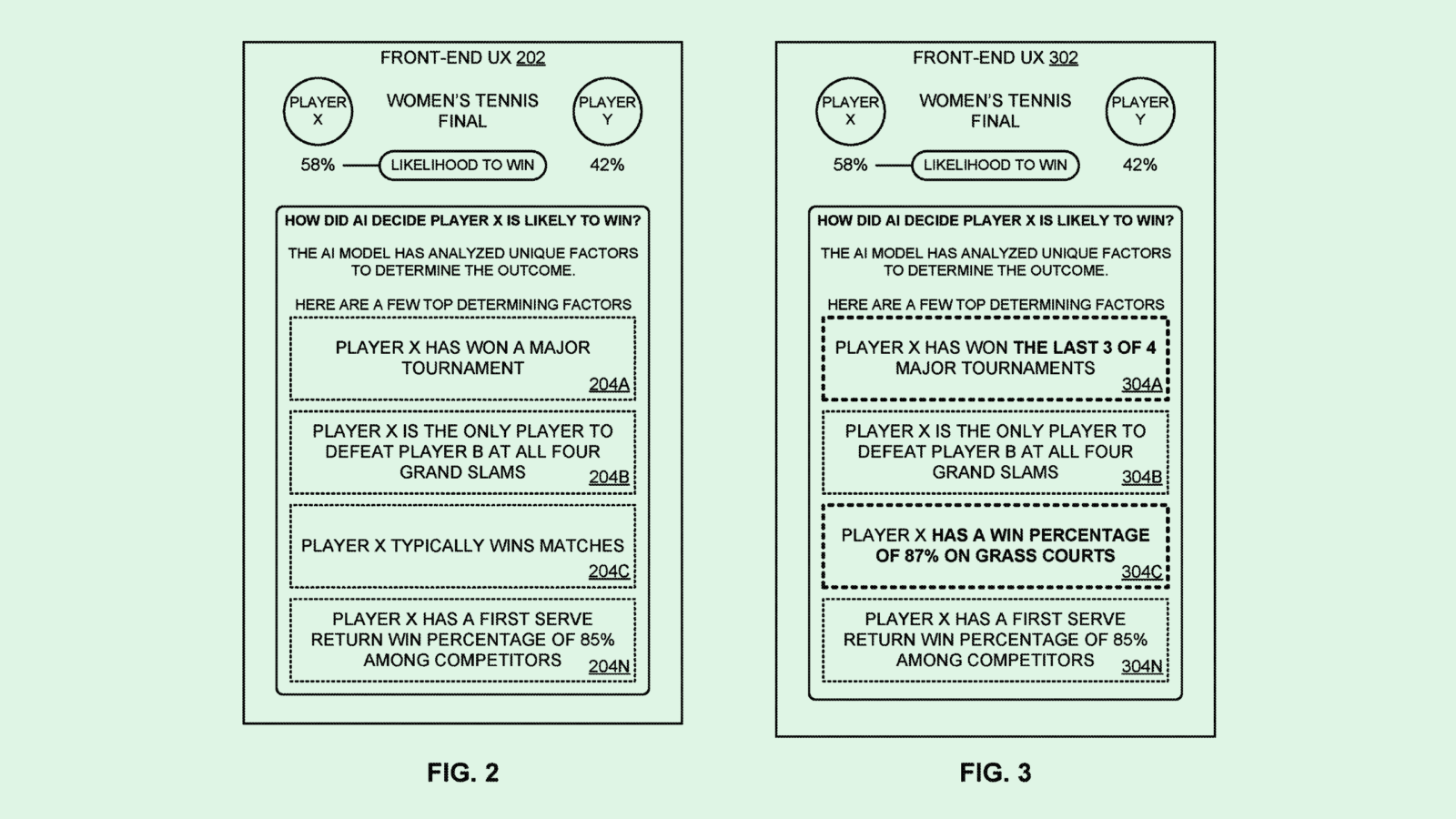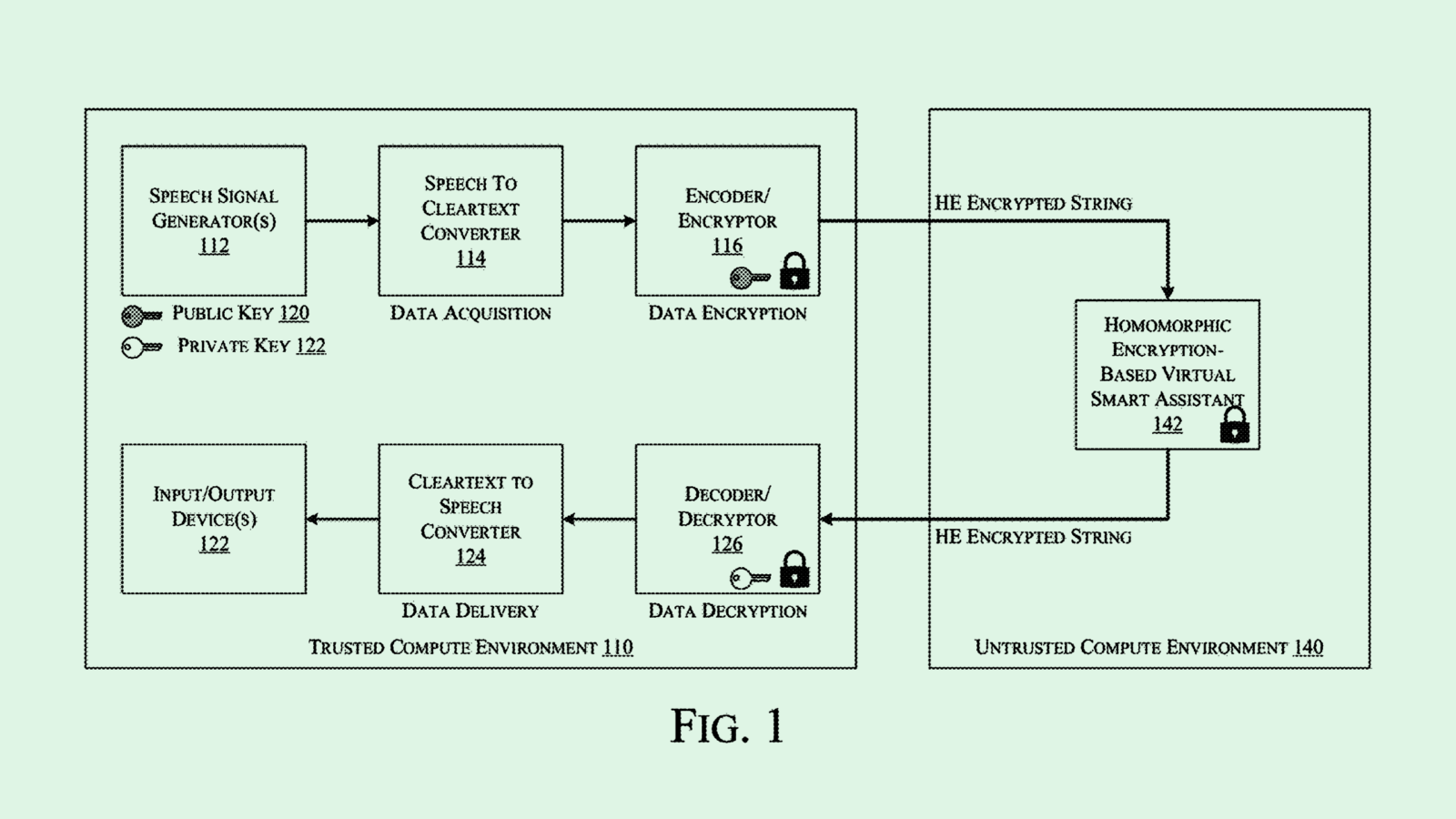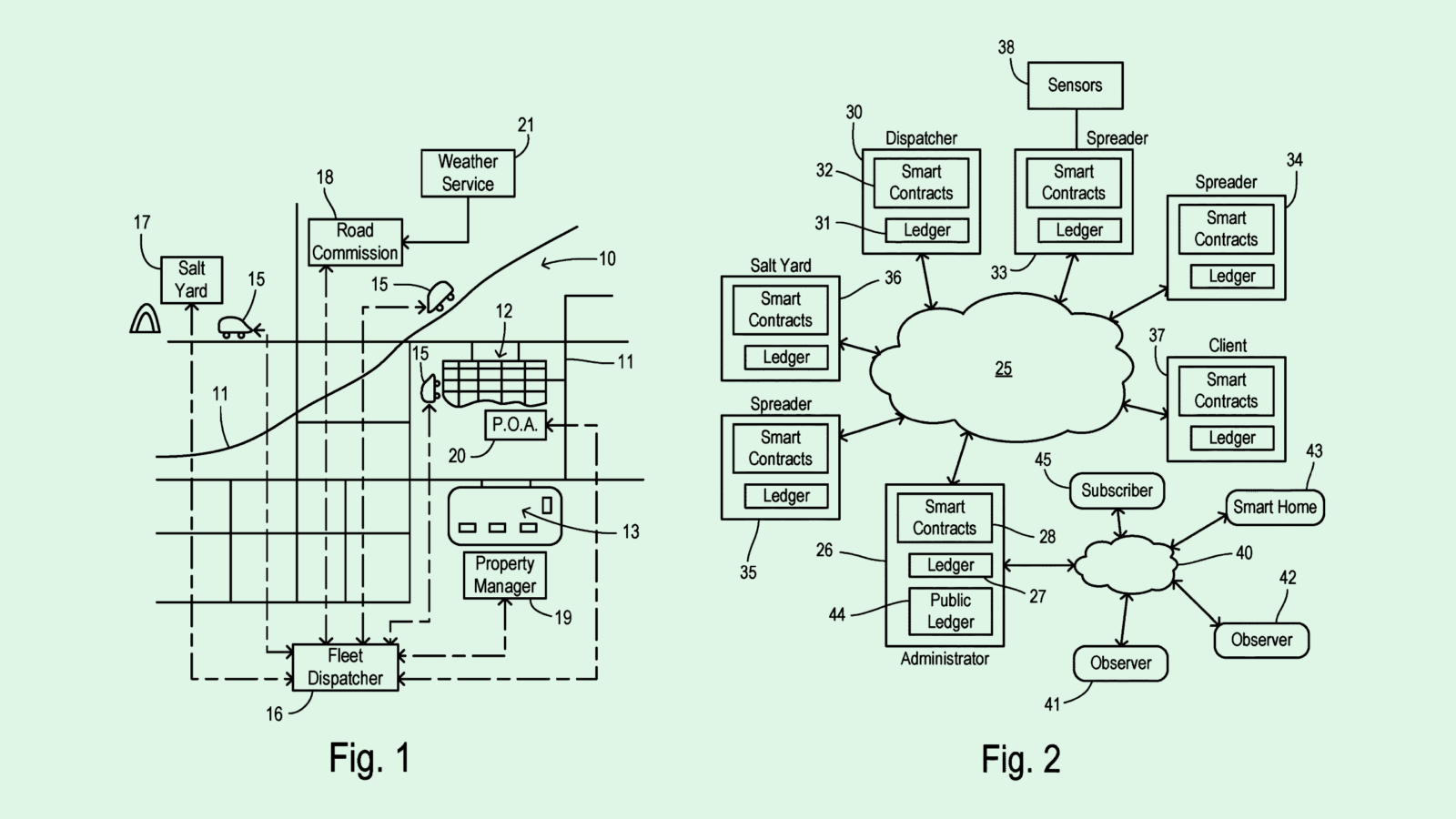Happy Monday and welcome to Patent Drop!
Today, IBM’s patent to measure the trustworthiness of AI systems signals the need for tech firms to build consumer confidence as AI continues its rapid exponential growth. Plus: Intel wants to keep your voice data safe, and Ford may be taking blockchain’s reputation issues with a grain of salt.
Let’s check it out.
IBM Goes for Trust
IBM wants to instill some confidence in AI systems.
The company seeks to patent a way to measure “artificial intelligence trustworthiness” based on the front-end user experience. IBM’s system aims to help AI companies and services identify where they can be more transparent about their outputs.
As AI becomes more advanced, so does the need for explainability, IBM noted. “Developers can help address this challenge by designing front-end (user experiences) … that provide explanations about how an AI model came to a decision,” IBM said. “However, it is often the case that a front-end UX simply provides a prediction output by an AI model with no further explanation.”
The system uses a machine learning algorithm to identify the parts of the user experience that convey information about its AI models. It then evaluates them to see if they meet certain thresholds of explainability, transparency, fairness, and “uncertainty quantification,” or a measure explaining how uncertain the AI model’s outputs may be.
The system then combines the different threshold scores to calculate an overall trustworthiness score for how the AI outcomes are explained. If a service falls below a certain threshold, IBM’s tech will recommend ways to fix its user experience.
For example, if a website that predicts tennis match outcomes says it chose the predicted winner in a match because they typically win matches, IBMs system may opt to be a little more precise, changing the wording to “Player X has a win percentage of 87%.”

Gaining consumer trust isn’t always an easy thing, especially in tech. Big tech firms have abused users’ trust on numerous occasions by not treating their data with the privacy it deserves. And amid the AI boom, in which large-scale models created by these big tech firms are hungry for data, consumers are growing even more skeptical.
A survey last year of more than 5,000 Americans out of Bentley University and Gallup found that 79% of respondents didn’t trust companies to use AI responsibly. This distrust is why it’s vital for AI developers to be forthright about what’s going on behind the curtain, said Arti Raman, founder and CEO of AI data security company Portal26.
“As humans, we have an inherent distrust of automation and automated systems,” said Raman. “If businesses are able to win people to trust, then the competitive advantage and the productivity and value creation process is so much faster.”
There are a few potential avenues to win trust, Raman said. One is explainable AI, in which AI models aren’t stuck in so-called black boxes, but rather show how they arrive at their predictions. Another route is disclosing exactly what the AI model’s capabilities are — and what their capabilities aren’t — a service that IBM’s patent aims to offer.
“AI is a really complicated thing,” Raman said. “And I think that people don’t trust things they don’t understand.”
Finally, there’s the “old-fashioned seal of approval route,” said Raman. Creating oversight organizations that indicate which AI systems are ethical and safe could help consumers of AI products feel more comfortable.
However, consumers have every right to have a healthy skepticism of the AI they’re using. OpenAI, Google, and Microsoft have all faced data vulnerabilities relating to their massive AI operations. And if you use any big tech company service, that means you’re also likely helping train their AI inadvertently, said Raman.
“If AI is baked into my Google workspace, I am the product,” Raman said. “And I actually would very much like to know exactly how it’s working and have evidence of that.”
Intel Saves Your Voice
Intel wants to give you peace of mind when talking to your digital assistant.
The company filed a patent application for a “privacy preserving digital personal assistant.” Rather than sending your raw voice data to the cloud for processing, Intel’s tech encrypts that data to keep your personal information and identity from being shared in that environment.
“Existing digital personal assistant technologies force users to surrender the content of their voice commands to their digital personal assistance provider, and most actions of the available digital personal assistants are performed in the cloud,” Intel said in the filing. “This presents a large privacy and security concern that will only grow (over time) with increased adoption.”
In these cases, Intel noted, voice data is only protected with traditional encryption and cybersecurity measures once it’s already in the cloud environment. Intel’s system differs in that it relies on homomorphic encryption to protect user data. This kind of encryption allows computation to be performed on the data without revealing the data itself.
When a user gives Intel’s system a verbal command, it uses homomorphic encryption on that data locally on the device. This system may do this by using speech-to-text on the command, then pulling out specific keywords and encrypting those for further processing. Finally, it transmits that data to a cloud environment hosting a natural language processing algorithm, which understands and responds to the user’s request.
Along with keeping speech data safe, Intel notes that its method may reduce processing time and resources needed, thereby cutting down wait times in user interactions with the device.

Tech firms are really keen on getting digital assistants right. Plenty of patents take different approaches to make these devices better listeners: Google has filed several applications for ways to monitor on-screen user activity, pick up on physical visual cues and location-based context to make its assistants sharper; Amazon wants to listen in for environmental noises; and Apple wants to watch for optical triggers to tell where voices are coming from.
The end goal is to make these devices more intuitive, aiming to increase reliance and adoption by making these assistants more useful. Many have sought to do this by watching users closely, eliminating wake words, or embedding this tech throughout your household, aiming to pick up on more context on user habits. The problem with that, however, is the privacy that users are giving up for that convenience.
Privacy issues can arise if that data is processed in a cloud environment, rather than on the device itself. If there is a breach and user voice data isn’t protected properly, it could leave a massive amount of personal information vulnerable.
Intel’s system, however, goes in the opposite direction of most digital assistant-related patents. This tech aims to preserve privacy by encrypting the data at the source, and only taking what it needs to properly respond to requests.
Though Intel isn’t exactly known for its smart voice assistants when compared to the likes of Apple, Amazon, or Google, it could be creating this software to license it to other voice assistant developers as adoption of the technology continues to grow. This kind of data protection could be especially pertinent in the advent of AI-based digital assistants.
Plus, Intel has long been overshadowed by Nvidia in the AI race, particularly for its chips. Expanding its software options and giving niche offerings to do AI right, such as protecting privacy, promoting ethics, or eliminating bias, could be a way in which it aims to stand out among the competition.
Ford’s Pillar of Salt
Ford may put blockchain to use after winter storms.
The company is seeking to patent a “smart road salt distribution system” using a blockchain network. As the title of this patent implies, Ford’s system intends to monitor the distribution of road salt for both environmental and economic purposes.
“Trust among the administrators and the spreading vehicles may be eroded due to haphazard monitoring, salt runoff, or incomplete communications,” Ford said in its filing. “Through better monitoring and use of adaptive control, the spreading of excessive salt or other substances can be avoided.”
Here’s how it works: When a “salt-spreading agent” does their job, they would log the salt they’d spread on a “permissioned” blockchain ledger as a transaction record of their activities. Different transactions may be in place for different activities, such as one for routing, one for salt loading and another for salt output.
The ledger would essentially provide an immutable record of how much salt has been dispersed, which roads have been salted, and by which agents. Ford noted that the salt vehicles themselves may be equipped with sensors, such as lidar, cameras, temperature sensors, and “wheel slip sensors” to get a sense of environmental data and road conditions, preventing a worker from treating a road with salt if it isn’t necessary.
“Data is collected and used to mitigate … environmental damage, reduce costs, and create less damage to the roads,” Ford noted.

Though most people wouldn’t typically think to use “blockchain” and “road salting” in the same sentence, this method of immutable and transparent tracking presents a stopgap solution to a larger issue: Road salt can be awful for the environment.
With more than 20 million metric tons of salt spread across US roads each year, this de-icing method can contaminate water sources and endanger wildlife with increased freshwater salinity. While Ford’s system isn’t necessarily solving the environmental impact, it’s limiting the harm to a minimum.
Broadly, Ford’s incredibly niche use case for blockchain is another example of how this tech can be applied outside of cryptocurrency or digital asset contexts. Several patent applications reveal different ways companies may be putting this tech to use, including Sony using the tech to track down deepfakes, eBay employing it to ward off scammers, and Baidu utilizing it to lock down its cloud environments. Another eBay patent similarly puts blockchain to work in physical contexts, aiming to secure shipping and delivery interactions.
If these filings point to anything, it’s that companies are seeking to use blockchain’s main benefits of immutable and transparent record keeping and authentication. And if blockchain can overcome its bad reputation, even a company like Ford, which sits far from the world of crypto and NFTs, can find a use for its underlying tech.
Extra Drops
- Google’s getting into the kitchen. The company wants to patent an AI-based system for “smart recipe generation.”
- Oracle wants to make sure your expenses are in order. The company wants to patent machine learning-based anomaly detection for expense reports.
- Adobe wants to test your photoshop skills. The company wants to patent a method for “customizing digital content tutorials” based on a user’s proficiency with the tool.
What Else is New?
- Apple is in talks with Google to license Gemini for integration into iPhones. Sources told Bloomberg that the companies “haven’t decided the terms or branding of an AI agreement.”
- LinkedIn may be planning to add gaming to its platform, according to TechCrunch. It’s currently working on three games, called “Queens,” “Inference” and “Crossclimb.”
- Fisker is pausing production of its Ocean SUV electric cars for six weeks as it scrambles for cash. A regulatory filing showed that the company has just $121 million in the bank.
Patent Drop is written by Nat Rubio-Licht. You can find them on Twitter @natrubio__.
Patent Drop is a publication of The Daily Upside. For any questions or comments, feel free to contact us at patentdrop@thedailyupside.com.
